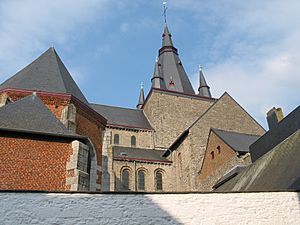Soignies facts for kids
Quick facts for kids
Soignies
Sougniye (Picard)
Zinnik (Dutch)
|
|||
|---|---|---|---|
![The Saint-Vincent collegiate church [fr] (10th century) and the square on the "Place Verte"](/images/thumb/5/50/Soignies_JPG001.jpg/250px-Soignies_JPG001.jpg)
The Saint-Vincent collegiate church (10th century) and the square on the "Place Verte"
|
|||
|
|||
| Country | Belgium | ||
| Community | French Community | ||
| Region | Wallonia | ||
| Province | Hainaut | ||
| Arrondissement | Soignies | ||
| Area | |||
| • Total | 110.30 km2 (42.59 sq mi) | ||
| Population
(2018-01-01)Lua error in Module:Wd at line 1575: attempt to index field 'wikibase' (a nil value).
|
|||
| • Total | Lua error in Module:Wd at line 1,575: attempt to index field 'wikibase' (a nil value). | ||
| Postal codes |
7060-7063
|
||
| Area codes | 065/067 | ||
| Website | www.soignies.be | ||
Soignies is a town in Wallonia, Belgium. It is located in the province of Hainaut. The town is known for its beautiful old buildings and its history.
Soignies is made up of several smaller areas called districts. These include Casteau, Horrues, and Naast. One of these districts, Casteau, is famous because it's home to SHAPE. This is the main military headquarters for NATO, a group of countries working together for defense. SHAPE has been in Casteau since 1967.
The name Soignies comes from an old Latin word, suniacum. This means "on the Senne," referring to the Senne River. The river starts near Soignies and then flows through the big city of Brussels. Soignies is also well-known for its blue limestone and its glass industry.
Contents
A Look into Soignies' Past
The history of Soignies goes back a very long time. People have lived in this area since at least the 7th century.
Saint Vincent's Story
In the 670s, a wealthy man named Madelgaire and his wife Waltrude decided to live a religious life. They both started monasteries. Madelgaire founded his in Soignies. He later became known as Vincent. After they passed away, both Madelgaire (Vincent) and Waltrude became saints. Saint Vincent is now the special patron saint of Soignies.
Back then, a huge forest covered the area. Parts of this forest still exist near Brussels today. It is called the Sonian Forest. The monastery in Soignies was first mentioned in a very old document from 870.
The Age of Canons
Around the end of the 800s, a group of powerful religious leaders called canons took over the monastery. Unlike monks, these canons did not take a vow of poverty. They stayed in charge for about 800 years, until the French Revolution.
In the 10th century, the canons started building the impressive church of Saint Vincent. It was finished in the next century, built in the Romanesque style. This style is known for its thick walls and round arches. The church became very famous. In the 13th century, visitors to the church could even receive a special blessing.
Around the same time, Soignies grew into a town. People started working in the textile industry, making cloth. The town also built walls to protect itself. Stone quarries, where special local stone was dug up, started around 1400. However, the business of cutting and shaping this stone really began around 1700.
From Revolution to Today
In 1796, during the French Revolution, the local government run by the canons was stopped. This was a big blow to the town's economy. By 1812, only a small number of people worked in the quarries.
However, the stone industry got better when the Dutch ruled the area. It grew even more after the Belgian Revolution in 1830, when Belgium became an independent country.
Today, the stone-cutting and glass industries are still important in Soignies. The town is also a center for services like education and healthcare.
Places to See in Soignies
- The Collegiate Church of St Vincent is one of the oldest Romanesque churches in Belgium. The oldest parts of the church are from the early 11th century. The tall, pointed tower was added later, around 1250, in the Gothic style. You can still see very old tombs from the 13th and 14th centuries in the church cemetery.
- Near the church is the Cloth Market (in French, Halle aux Draps). This building dates back to the 16th century.
Fun Events and Festivities
- The Procession of Saint Vincent is a very old tradition. It has been happening since at least the 13th century! Every year, on the Monday of Pentecost, a special container holding the relics of Saint Vincent is carried in a historic procession. This procession follows a special 11-kilometer route around the town, known as the Grand Tour Saint Vincent.
- The town also has a local carnival called La Simpélourd. It takes place on the Saturday before the third Sunday of October.
Sports in Soignies
Soignies is home to the Rugby Union club RC Soignies. This team won the Belgian Cup in 2010!
Famous People from Soignies
- Samo: A Frankish merchant who became a king in the 7th century.
- François de Cuvilliés: A famous architect from the 17th century.
- Jules Bordet: An immunologist and microbiologist who won the Nobel Prize.
- Paul van Zeeland: A lawyer, economist, and politician.
- Johan Walem: A well-known football player and TV expert.
- Chris Richardson: An American singer-songwriter.
See also
 In Spanish: Soignies para niños
In Spanish: Soignies para niños






